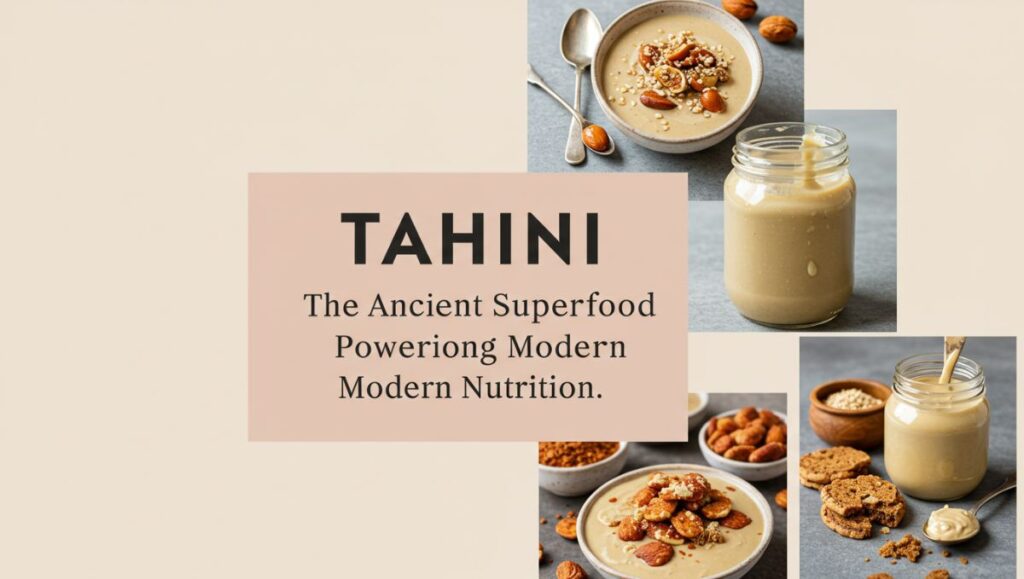In the world of healthy, plant-based foods, few ingredients are as versatile and nutrient-rich as tahini. Made from ground sesame seeds, tahini has been cherished for centuries in Middle Eastern and Mediterranean cuisines. Today, it’s making a global comeback as a superfood—loved by chefs, nutritionists, and wellness enthusiasts alike.
What Is Tahini?
Tahini is a creamy paste made from hulled or unhulled sesame seeds. It has a nutty, earthy flavor that can be rich and slightly bitter, depending on how it’s prepared.
It is a staple in:
-
Middle Eastern dishes like hummus, baba ganoush, and falafel.
-
Mediterranean cuisine, where it’s used in sauces, dressings, and dips.
-
Modern healthy diets, where it appears in smoothies, energy bars, and vegan desserts.
A Brief History of Tahini
The history of tahini stretches back thousands of years. Sesame seeds were cultivated as early as 3500 BCE in Mesopotamia, and the paste we now call tahini has roots in ancient Persia, the Levant, and North Africa.
Historically, sesame seeds were valued for:
-
Longevity and vitality in ancient civilizations.
-
Use in religious rituals and medicinal remedies.
-
Culinary roles across cultures, from the Middle East to Asia.
Today, ta-hini remains a symbol of heritage and wellness, bridging tradition with modern nutrition.
Nutritional Profile of Tahini
Tahini is not only delicious but also packed with nutrients. A two-tablespoon serving typically provides:
-
Healthy fats: Monounsaturated and polyunsaturated fats for heart health.
-
Protein: Around 5g per serving, making it great for plant-based diets.
-
Vitamins: Rich in B vitamins (B1, B2, B3, B5, and B15) for energy.
-
Minerals: High in calcium, magnesium, phosphorus, iron, and zinc.
-
Antioxidants: Including lignans like sesamin and sesamol, known for anti-inflammatory benefits.
This makes ta-hini a nutrient-dense superfood that supports overall wellness.
Health Benefits of Tahini
1. Supports Heart Health
The unsaturated fats in ta-hini help lower bad cholesterol (LDL) while boosting good cholesterol (HDL), promoting cardiovascular health.
2. Rich in Plant-Based Protein
For vegetarians and vegans, ta-hini provides an excellent source of protein to support muscle repair and energy.
3. Strengthens Bones
With its high calcium and magnesium content, tahini is beneficial for bone strength and density.
4. Boosts Immunity
Zinc and antioxidants found in ta-hini strengthen immune defense and reduce inflammation.
5. Aids Digestion
Its fiber content supports healthy digestion and gut balance.
Culinary Uses of Tahini
Tahini’s versatility makes it a favorite in both traditional and modern kitchens.
Classic Uses
-
Hummus: Blended with chickpeas, garlic, and lemon juice.
-
Baba Ganoush: Combined with roasted eggplant for a smoky dip.
-
Ta-hini Sauce: A staple dressing for falafel, shawarma, and kebabs.
Modern Creative Uses
-
Smoothies: Adds creaminess and protein.
-
Energy Balls & Bars: Used as a natural binder with oats, nuts, and seeds.
-
Vegan Desserts: Swirled into brownies, cookies, or halva-inspired sweets.
-
Salad Dressings: Blended with lemon, garlic, and herbs for a nutritious drizzle.
Tahini in Vegan and Plant-Based Diets
As more people adopt vegan and plant-based lifestyles, ta-hini has become an essential ingredient. It provides:
-
Healthy fats for energy and satiety.
-
Non-dairy calcium for strong bones.
-
Protein to complement other plant-based foods.
This makes it a powerhouse for those avoiding animal products.
Choosing the Right Tahini
Not all ta-hini is the same. The quality depends on:
-
Hulled vs. Unhulled Seeds: Hulled seeds produce smoother, lighter ta-hini; unhulled seeds create a richer, more bitter paste but with higher nutrition.
-
Roasted vs. Raw: Roasted sesame seeds yield a deeper flavor, while raw tahini is milder.
-
Texture: The best tahini is smooth, pourable, and creamy—not dry or clumpy.
When buying, look for 100% sesame seed tahini without additives or oils.
Storage and Shelf Life
Tahini can separate over time, with oil rising to the top. This is natural—simply stir before use.
Storage tips:
-
Keep unopened jars in a cool, dark place.
-
Once opened, refrigerate to extend freshness.
-
Consume within 6 months for the best flavor.
Global Popularity and Modern Trends
Once a niche ingredient, tahini is now a global food trend. It’s gaining popularity in:
-
Health-conscious diets like keto, paleo, and vegan.
-
Gourmet cuisine, used by chefs worldwide.
-
Snack products, including tahini-based spreads and energy snacks.
From New York cafés to Tokyo health bars, tahini is redefining the meaning of “ancient superfood.”
Conclusion
Tahini is more than just a sesame paste—it’s a nutritional powerhouse with deep cultural roots and modern-day appeal. Rich in healthy fats, protein, and essential minerals, it supports heart health, immunity, digestion, and overall wellness. Its versatility in both traditional dishes and innovative recipes makes it a must-have in every kitchen.
As the world embraces healthier, plant-based lifestyles, ta-hini stands out as a timeless ingredient that bridges tradition with modern nutrition.






